20 Professional Lease Termination Templates for Quick & Easy Use
Our “Lease Termination Letters” page is your go-to resource for navigating the process with confidence and clarity. Whether you’re a tenant seeking to end your or a landlord responding to a termination request, we have you covered. Our collection of professionally crafted letter templates ensures clear communication and adherence to legal requirements. Explore informative guides on legal considerations, common pitfalls to avoid, and tenant rights to make informed decisions. With our comprehensive tools and insights, we strive to make lease a stress-free experience, fostering positive relationships between tenants and landlords. Trust us to be your reliable companion in achieving a smooth and respectful journey.
Benefits of Properly Written Lease Terminations
Properly written lease termination offers numerous benefits for both tenants and landlords. Here are some advantages of sending a formal and well-written letter:
- Clear Communication: A well-crafted ensures unambiguous communication between tenants and landlords. It outlines the intent to terminate the lease straightforwardly, reducing the risk of misunderstandings or misinterpretations.
- Legal Protection: A formal letter serves as a written record of the tenant’s intent to end the lease agreement. It helps protect both parties’ legal rights and provides evidence of compliance with any notice periods required by local laws.
- Establishing Official Notice: By sending a lease letter, tenants fulfill their obligation to provide proper notice to the landlord, as specified in the agreement or local regulations. This prevents any disputes or claims related to insufficient notice.
- Clarifying Termination Date: The letter clearly states the date when the lease will end, providing both tenants and landlords with a definitive timeline for the move-out process and other necessary arrangements.
- Demonstrating Professionalism: A well-drafted lease letter reflects the tenant’s or landlord’s professionalism and respect for the other party. It maintains a positive relationship and minimizes potential conflicts during the termination process.
- Minimizing Disputes: By documenting the reasons for the lease, tenants can minimize potential disagreements with landlords. It can help avoid disputes over early termination fees or security deposit refunds.
- Facilitating Transition: A formal letter allows both parties to plan and make necessary arrangements for the termination, such as finding new tenants or seeking alternative housing.
- Proof of Compliance: Landlords may need to show proof of proper notice given by tenants in case they encounter legal challenges or disputes.
- Preventing Automatic Renewals: In cases where lease agreements have automatic renewal clauses, a termination ensures that the lease does not renew unintentionally.
- Adherence to Lease Terms: Sending a formal letter demonstrates that both tenants and landlords are adhering to the agreement’s provisions, fostering a sense of trust and accountability.
Common Mistakes to Avoid
Common Mistakes to Avoid When Handling Lease Termination:
- Verbal Notice: Providing verbal notice of lease termination is a common mistake. Verbal notices are often informal and lack documentation, leading to disputes over the validity of the notice.
- Insufficient Notice Period: Failing to adhere to the required notice period specified in the lease agreement or local laws can lead to complications and potential legal issues.
- Incomplete or Vague: A poorly written or vague letter may create confusion and misunderstandings between tenants and landlords.
- Ignoring Lease Termination Provisions: Neglecting to follow the specific procedures outlined in the agreement can lead to disagreements and additional expenses.
- Forgetting to Document Property Condition: Neglecting to document the property’s condition during the move-out inspection can result in disputes over security deposit deductions.
- Failure to Communicate Changes in Circumstances: Tenants and landlords must communicate any changes in circumstances affecting the lease, such as delays or extensions.
- Ignoring Legal Obligations: Both parties must be aware of their legal obligations regarding termination, such as returning the security deposit within the required timeframe.
Tips to Avoid Pitfalls and Ensure a Smooth Process:
To avoid common termination mistakes and promote a smooth and amicable process, follow these tips:
- Put it in Writing: Always provide a written lease letter to document the intent and details of the termination.
- Check Lease Agreement and Local Laws: Review the agreement and local regulations to understand the required notice period and procedures.
- Be Specific and Clear: Ensure the termination is specific, stating the exact date and any other relevant details.
- Use Certified Mail: Send the letter via certified mail to have proof of delivery and receipt.
- Conduct Move-Out Inspection: Conduct a move-out inspection with the landlord present and document the property’s condition with photos or videos.
- Communicate Timely: Inform the landlord promptly about any changes in the termination date or circumstances.
- Understand Security Deposit Rules: Familiarize yourself with the rules and deadlines for returning the security deposit and follow them accordingly.
#1: Formal Lease Termination Notice
The Formal Lease Termination Notice is a professionally written addressed to the landlord to formally announce the tenant’s decision to terminate the agreement. The letter provides essential details such as the property address, the notice period, and the last day of occupancy. It expresses gratitude for the tenancy while adhering to the lease agreement and local laws. The tenant assures a well-maintained property upon departure and includes a forwarding address for future correspondence. The letter aims to maintain a positive relationship with the landlord throughout the termination process.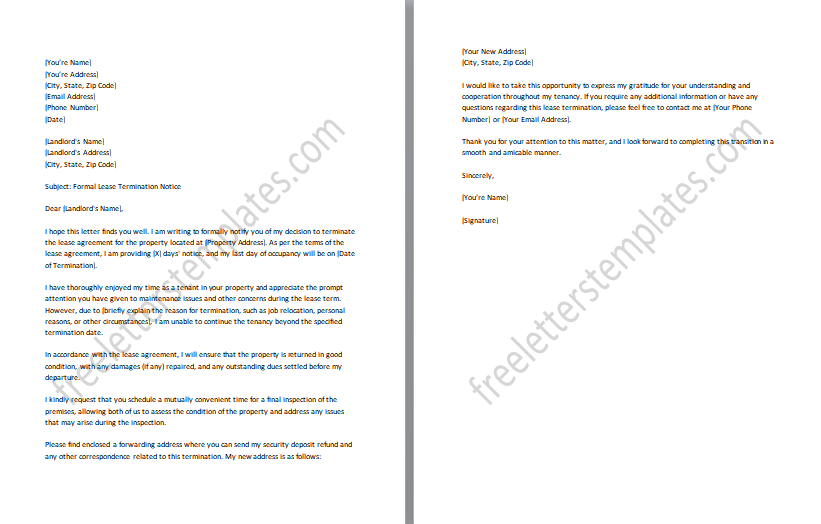
#2: Early Lease Cancellation Letter
The Early Lease Cancellation Letter is a written communication from a tenant to the landlord, requesting to terminate the agreement before its scheduled end date. The letter explains the reasons for the early cancellation, such as job relocation, personal circumstances, or other compelling factors. It acknowledges any potential penalties or fees associated with early termination and expresses a willingness to comply with the lease agreement’s requirements. The tenant provides a specific date and assures the landlord of leaving the property in good condition. It emphasizes gratitude for the landlord’s understanding and cooperation during this process and includes a forwarding address for future correspondence.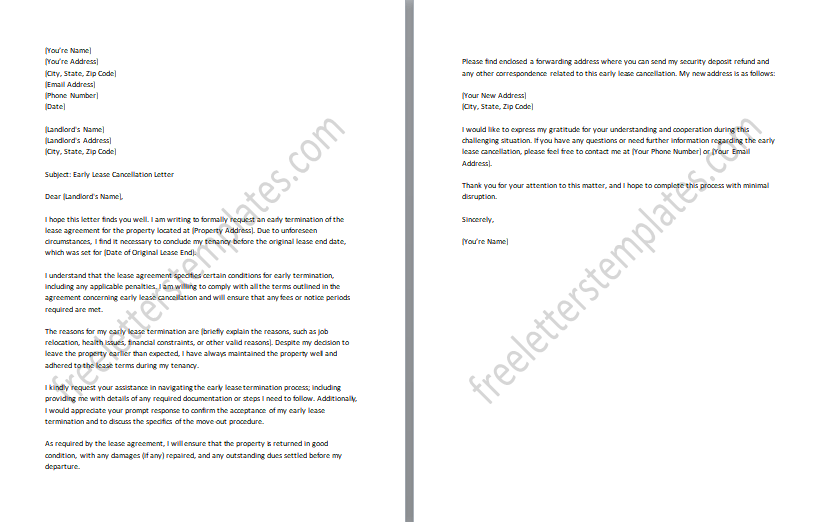
#3: Month-End Lease Termination Request
The Month-End Lease Request is a formal letter written by a tenant to the landlord, notifying them of the tenant’s intention to terminate the agreement at the end of the current month. The letter states the property address and provides a clear date, which aligns with the end of the current rental period. The tenant expresses appreciation for the rental experience but emphasizes the need to conclude the tenancy as planned. The letter assures the landlord of a smooth move-out process and a well-maintained property upon departure. It also includes a forwarding address for any future correspondence. It aims to maintain a positive landlord-tenant relationship while fulfilling the lease agreement’s requirements for providing notice of termination.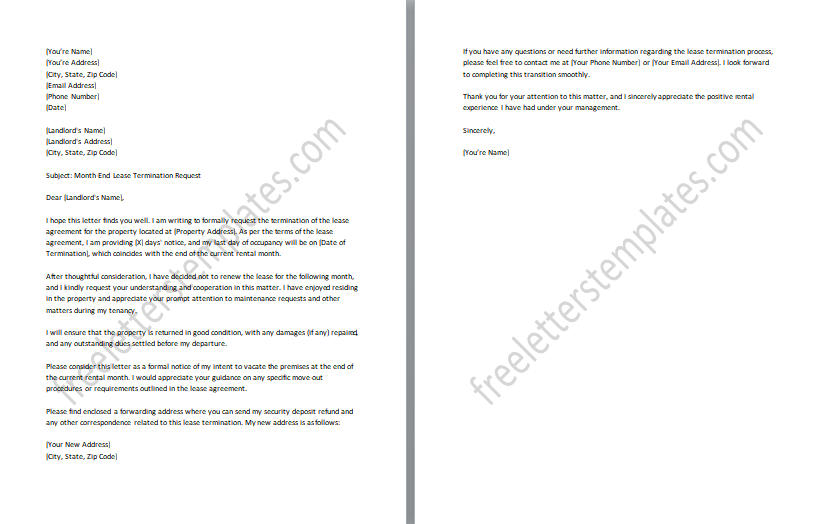
#4: Lease Non-Renewal Announcement
The Lease Non-Renewal Announcement is a formal communication from the tenant to the landlord, expressing the decision not to renew the current agreement upon its expiration. The letter states the property address and indicates the lease end date. The tenant expresses gratitude for the tenancy and acknowledges the option to renew the decides not to exercise it. The letter assures the landlord of a timely vacating process and a well-maintained property upon departure. It includes a forwarding address for future correspondence. It aims to maintain a positive relationship with the landlord while notifying them of the tenant’s intention to move on after the current term.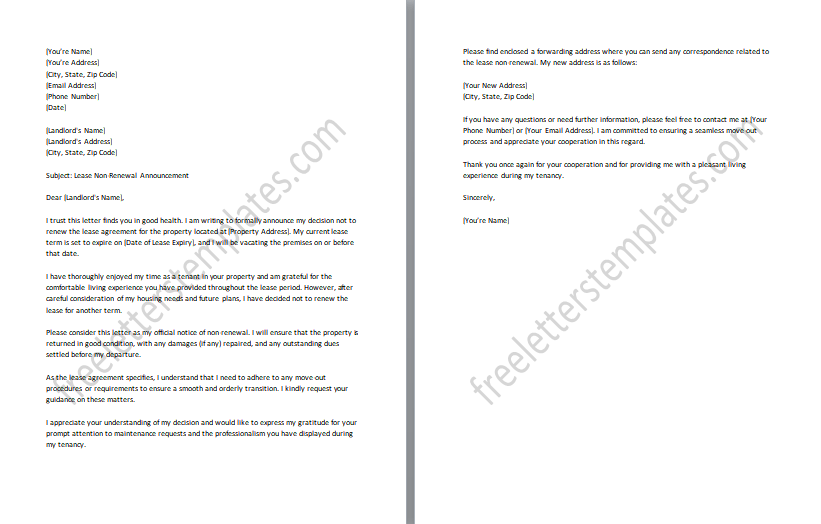
#5: Job Relocation Lease Termination Notice
The Job Relocation Lease Notice is a formal letter written by a tenant to the landlord, announcing the termination of the lease agreement due to a job relocation. The letter states the property address and details about the job relocation, such as the new location and start date. The tenant expresses appreciation for the rental experience and assures the landlord of adhering to the agreement’s termination terms and notice period. It includes a specific date, allowing sufficient time for the tenant to vacate the property. It also includes a forwarding address for future correspondence. It aims to maintain a positive relationship with the landlord while explaining the necessity to terminate due to the job relocation.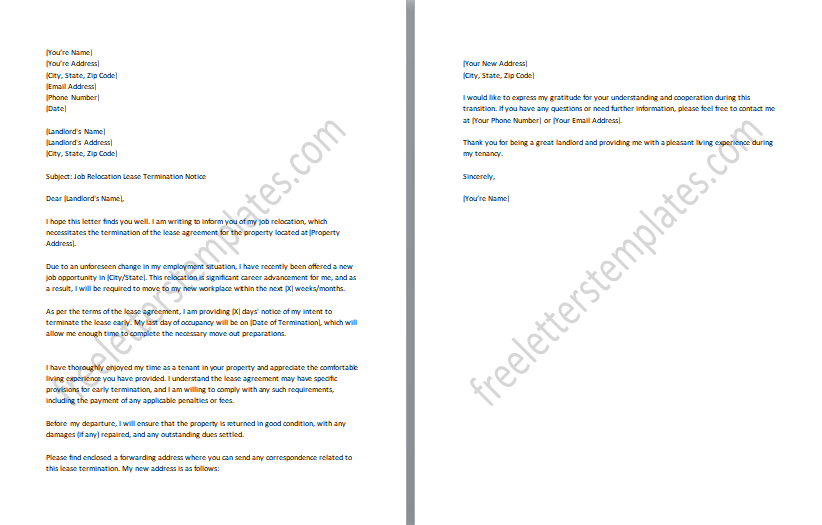
#6: Military Deployment Lease Termination Request
The Military Deployment Lease Termination Request is a formal letter written by a tenant in the military to the landlord, seeking early of the lease agreement due to military deployment. The letter states the property address and provides details about the upcoming deployment, including the deployment start date and expected duration. The tenant expresses appreciation for the rental experience and acknowledges any provisions that may apply to military personnel. It requests the landlord’s cooperation in facilitating an expedited process and includes a specific termination date. It assures the landlord of a well-maintained property upon departure and consists of a forwarding address for future correspondence.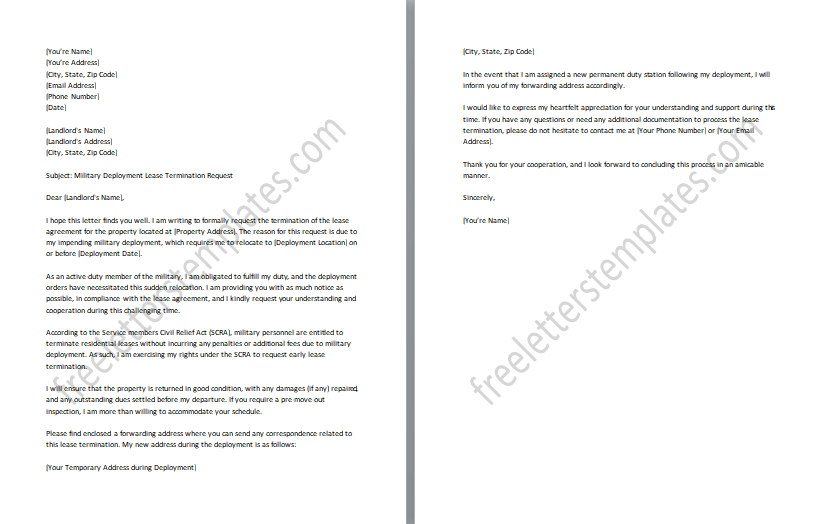
#7: Retirement Lease Agreement Termination
The Retirement Lease Agreement Termination is a formal letter written by a tenant to the landlord, informing them of the decision to terminate the agreement due to retirement. It states the property address and provides details about the retirement date and the reasons for the lease. The tenant expresses appreciation for the rental experience and acknowledges any notice periods required for lease termination. The letter aims to maintain a positive relationship with the landlord while explaining the necessity to terminate the due to retirement and changes in the tenant’s circumstances.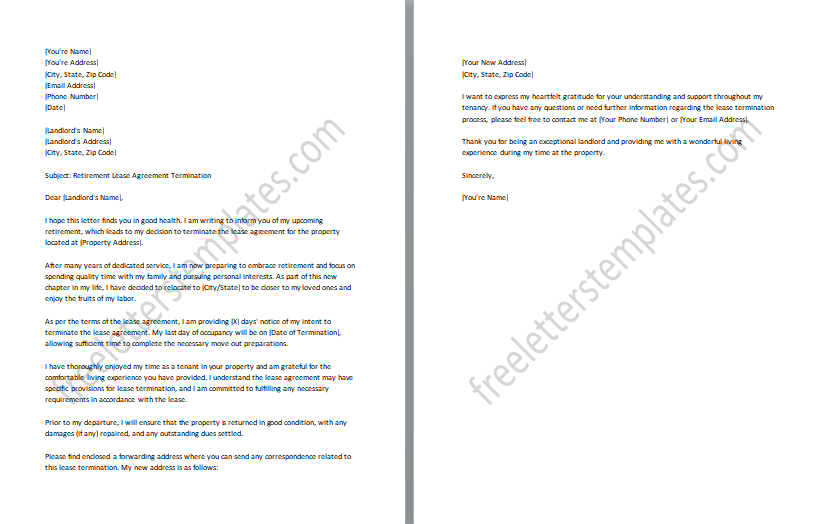
#8: Property Sale Lease Cancellation Letter
The Property Sale Lease Cancellation Letter is a formal communication from a tenant to the landlord, notifying them of the intent to cancel the agreement due to the sale of the rented property. It acknowledges the property’s impending sale and provides details about the expected sale date. The tenant expresses appreciation for the rental experience and acknowledges any provisions related to property sales. The letter requests the landlord’s cooperation in facilitating an early lease termination process and includes a specific date. It assures the landlord of a well-maintained property upon departure and consists of a forwarding address for future correspondence. It aims to maintain a positive relationship with the landlord while explaining the necessity to terminate due to the property’s sale.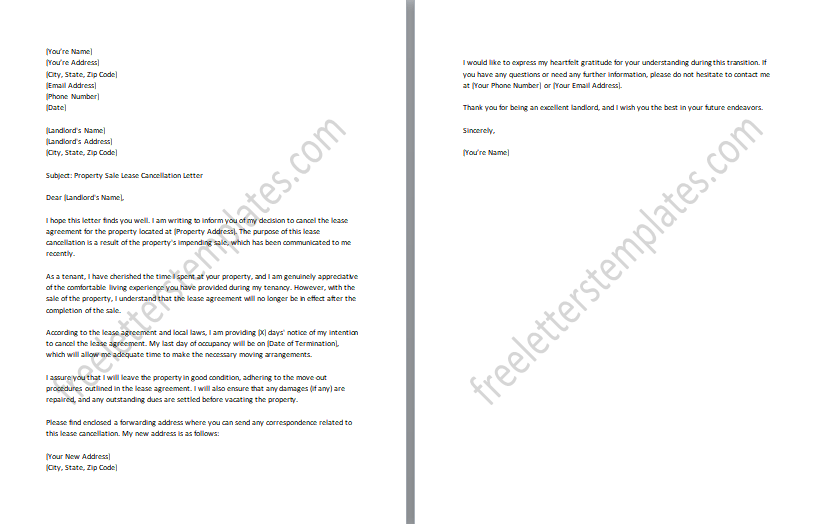
#9: Uninhabitable Property Lease Termination Notice
The Uninhabitable Property Lease Notice is a formal letter written by a tenant to the landlord, announcing the termination of the agreement due to the property’s uninhabitable conditions. It details the specific issues that make the property unsuitable for occupancy, such as safety hazards, severe damage, or health risks. The tenant expresses concerns about the unresolved problems and the impact on their living conditions. The letter cites relevant laws and provisions that protect tenants’ rights to live in habitable conditions. It requests the landlord’s immediate attention to rectify the situation and acknowledges any lease provisions that may apply in such circumstances. It provides a specific date, allowing sufficient time for the tenant to vacate the uninhabitable property.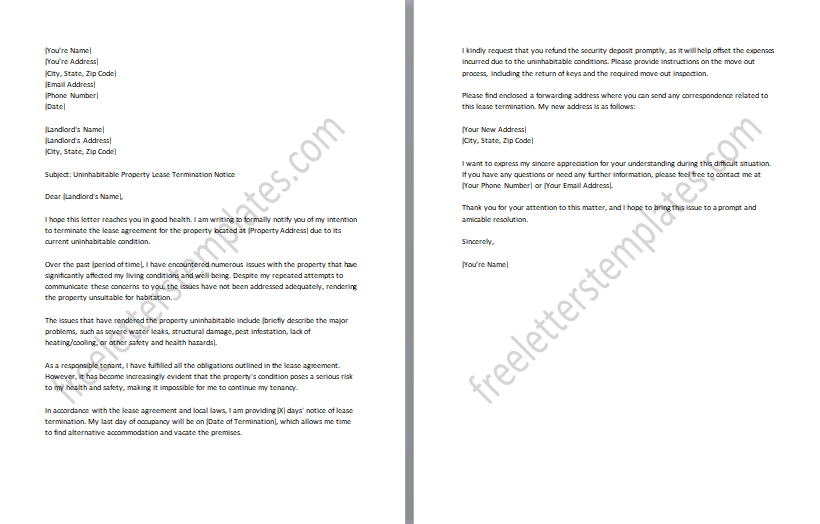
#10: Domestic Violence Lease Release Letter
The Domestic Violence Lease Release Letter is a compassionate and empathetic communication from a tenant to the landlord, requesting an early release from the agreement due to domestic violence concerns. It describes the challenging circumstances faced by the tenant and explains that the living environment has become unsafe and detrimental to their well-being. The tenant expresses the need for immediate relief and seeks understanding and support from the landlord in this difficult situation. The letter acknowledges any termination provisions that may apply in cases of domestic violence. It provides a specific date, allowing sufficient time for the tenant to make alternative living arrangements.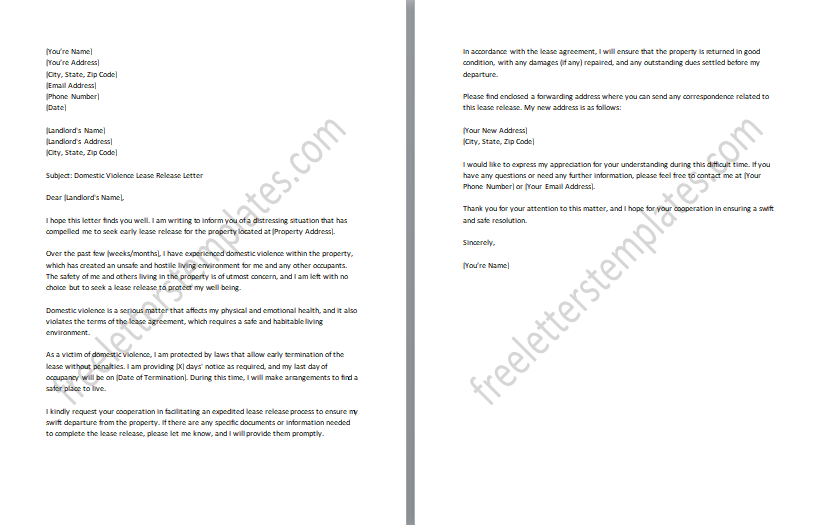
#11: Tenant Petition for Lease Termination
The Tenant Petition for Lease Termination is a formal and organized letter signed by multiple tenants, collectively requesting the early of the lease agreement. It provides background information, such as the property address and the names of all tenants involved. It states the reasons for seeking termination, which may include issues like ongoing maintenance problems, safety concerns, or violations of tenant rights. The letter highlights any documented communication with the landlord regarding the issues and outlines the steps taken to address the problems without satisfactory resolution. It includes a specific date and may cite relevant laws or regulations that protect tenants’ rights.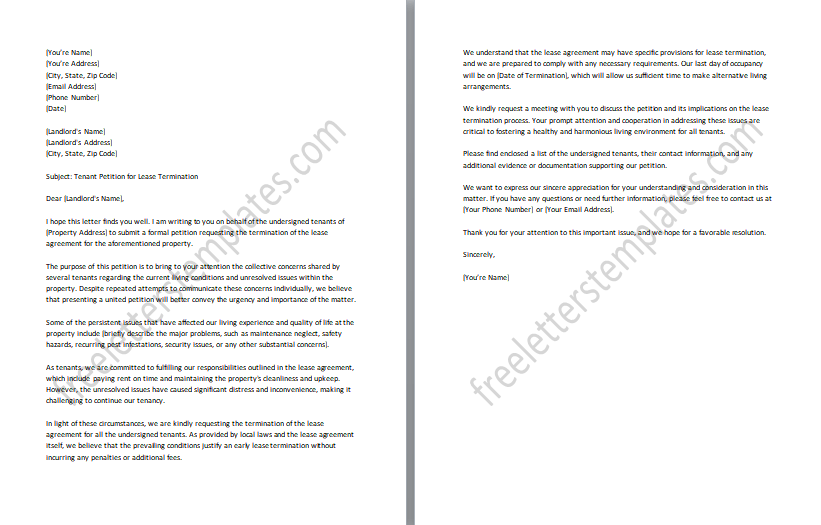
#12: Mutual Lease Termination Consent
The Mutual Lease Termination Consent is a formal agreement signed by both the landlord and tenant(s), mutually consenting to terminate the lease agreement early. The letter includes the property address, names of all parties involved, and the date of the mutual agreement. It briefly explains the reasons for the mutual decision, which may include changes in personal circumstances, financial considerations, or any other compelling factors agreed upon by both parties. It acknowledges any provisions and compliance with necessary notice periods or requirements. It assures the property will be returned in good condition, and any outstanding dues or obligations will be settled.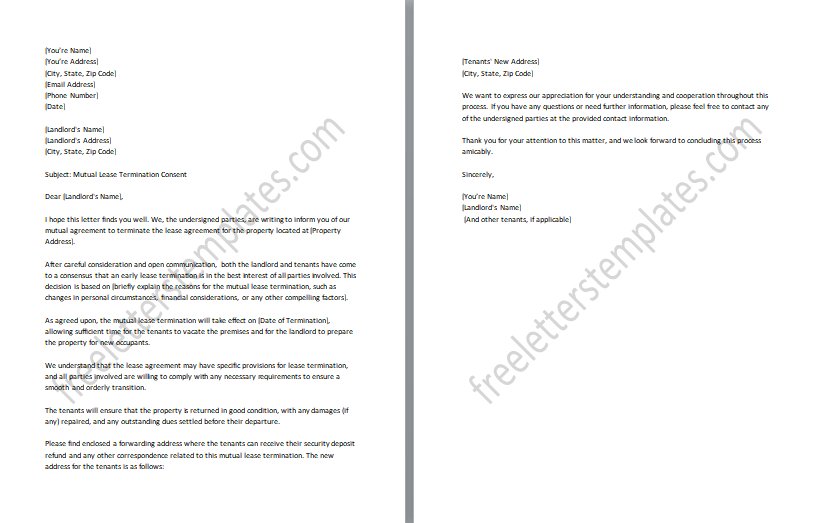
#13: Change in Financial Circumstances Termination Notice
The Change in Financial Circumstances Termination Notice is a formal letter written by a tenant to the landlord, notifying them of the need to terminate the lease agreement due to a change in financial circumstances. The letter states the property address and explains the financial challenges faced by the tenant, such as job loss, reduced income, or unexpected expenses. It expresses regret in having to terminate the lease but emphasizes the necessity to do so to alleviate financial strain. It acknowledges any termination provisions and provides a specific date, allowing sufficient time for the tenant to vacate the property. It assures the landlord of a well-maintained property upon departure and includes a forwarding address for future correspondence.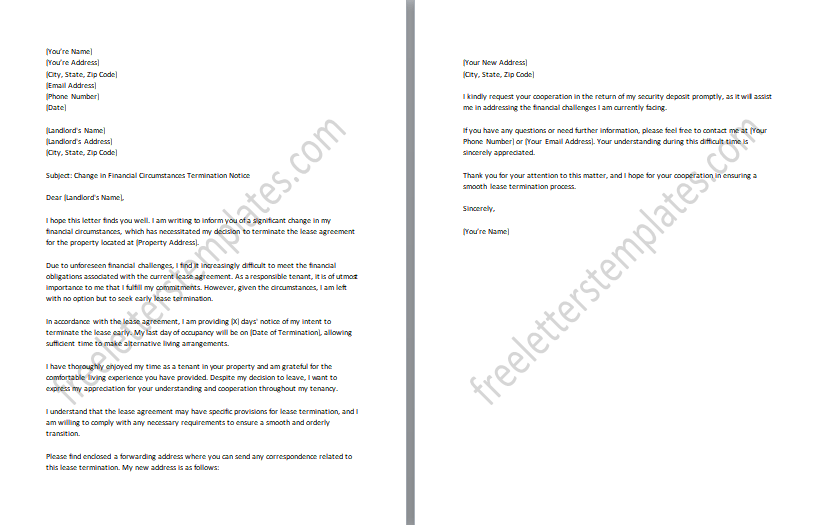
#14: Student Exchange Program Lease Cancellation
The Student Exchange Program Lease Cancellation is a formal letter requesting early of the lease due to participation in a student exchange program. It states the property address and the exchange program’s details, expressing appreciation for the rental experience and the educational opportunity. It acknowledges any termination provisions and provides a specific date, ensuring ample time to make necessary arrangements. The letter assures the landlord of a well-maintained property upon departure and includes a forwarding address. The aim is to maintain a positive landlord-tenant relationship while explaining the need to terminate the due to the enriching student exchange program, which will further the tenant’s education and personal growth.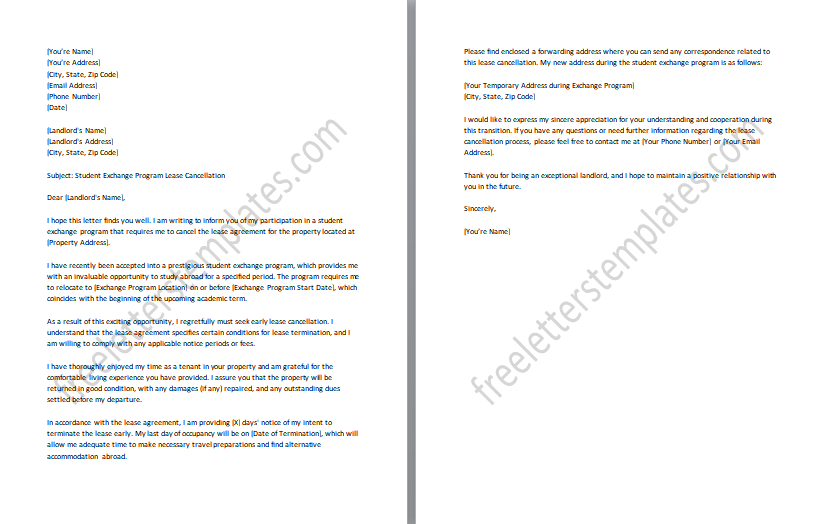
#15: Landlord’s Breach of Contract Lease Termination
The Landlord’s Breach of Contract Lease is a formal letter by a tenant to the landlord, announcing lease termination due to the landlord’s breach. It states the property address and specific instances of the breach. The letter expresses concern about living conditions and efforts to resolve issues. It cites relevant provisions protecting tenant rights. A specific date is provided, allowing time to vacate. It aims to assert tenant rights respectfully.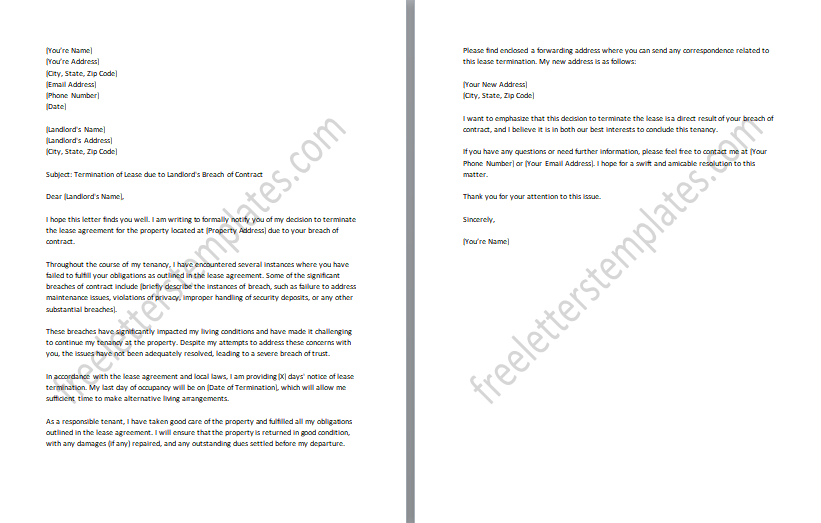
#16: Health-Related Lease Termination Letter
The Health-Related Lease Termination Letter is a formal notice from a tenant to the landlord, stating the decision to terminate the due to health reasons. It provides the property address and explains the health condition that makes it challenging to continue living there. It follows any lease provisions and gives a specific date to vacate the property. The tenant assures a well-maintained property upon departure and includes a forwarding address. The letter aims to maintain a positive relationship with the landlord while requesting understanding and cooperation during this difficult time.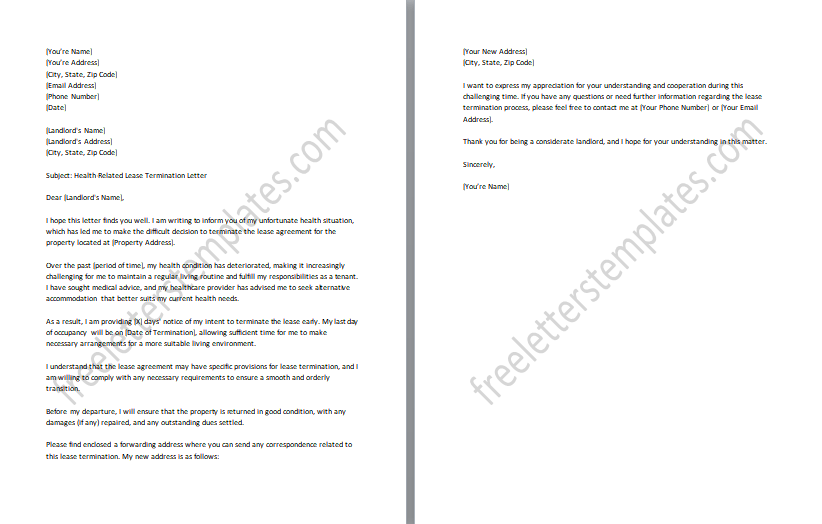
#17: Noise or Nuisance Lease Cancellation Request
The Noise or Nuisance Lease Cancellation Request is a formal letter from a tenant to the landlord, seeking early termination due to ongoing disturbances. The letter addresses the property location and describes the recurring noise or nuisance issues that disrupt the tenant’s peaceful enjoyment. It acknowledges any provisions for lease and provides a specific date, allowing time to vacate. The tenant assures a well-maintained property upon departure and includes a forwarding address. It aims to maintain a positive relationship with the landlord while requesting cooperation in resolving the disturbances and facilitating the cancellation.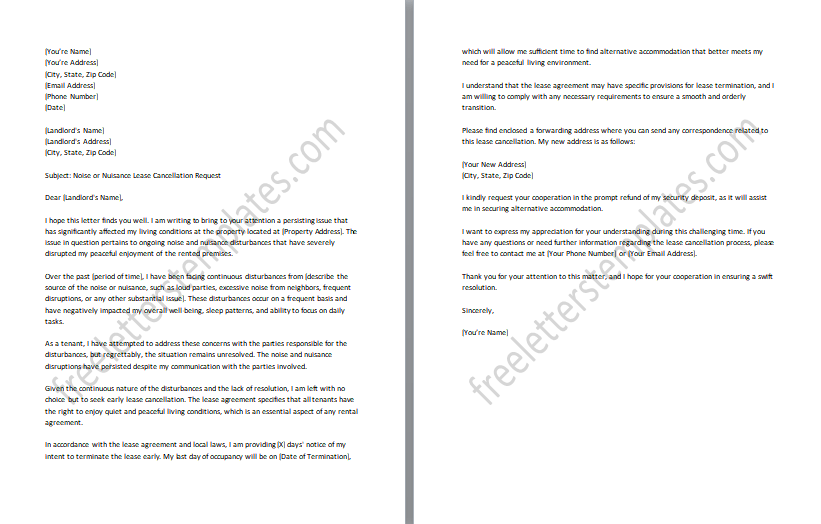
#18: Illegal Lease Agreement Termination Notice
The Illegal Lease Agreement Notice is a formal letter written by a tenant to the landlord, notifying them of the intention to terminate the agreement due to its illegality. It states the property address and highlights specific clauses or provisions of the agreement that violate local laws or regulations. It expresses regret in having to terminate but emphasizes the necessity to do so to comply with the law. The letter acknowledges any lease termination provisions and provides a specific date, allowing sufficient time for the tenant to vacate the property. It assures the landlord of a well-maintained property upon departure and includes a forwarding address for future correspondence. It aims to maintain a respectful approach while asserting the tenant’s rights and seeking a prompt resolution to the termination.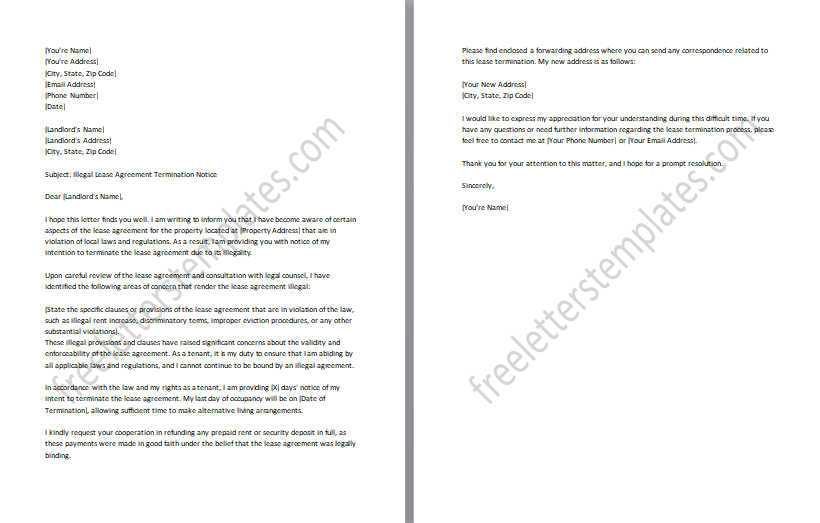
#19: Unauthorized Subletting Lease Termination
The Unauthorized Subletting Lease Termination is a formal letter from a tenant to the landlord, notifying them of the decision to terminate the agreement due to unauthorized subletting. The letter addresses the property location and explains that someone has been occupying the premises without proper approval. It expresses regret in having to terminate but emphasizes the seriousness of the violation. It acknowledges any lease provisions and provides a specific date, allowing time for the tenant to vacate. The tenant assures a well-maintained property upon departure and includes a forwarding address. The letter aims to maintain a positive relationship with the landlord while requesting their cooperation in resolving the issue and facilitating the termination.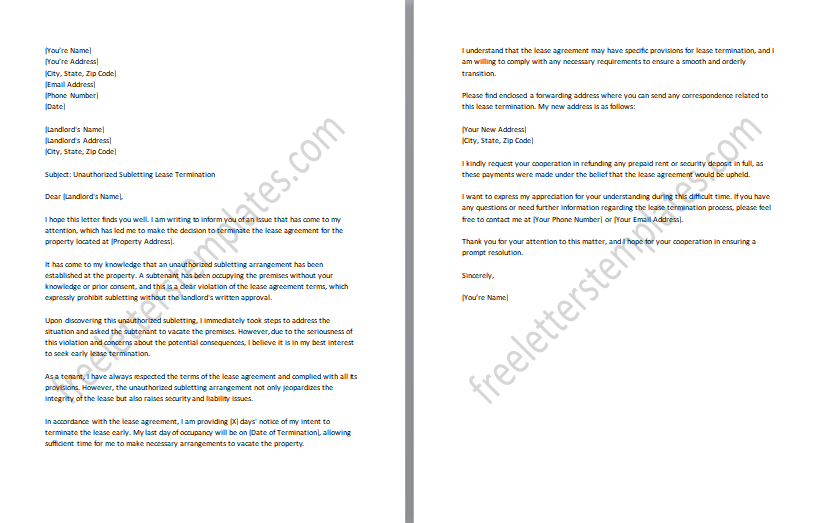
#20: Protest Against Excessive Rent Increase
The Protest Against Excessive Rent Increase is a formal letter written by a tenant to the landlord, expressing strong opposition to a substantial rent increase. It provides the property address and explains the financial burden posed by the proposed increase, which significantly exceeds market rates. The tenant acknowledges the landlord’s right to adjust rent but highlights the unreasonable nature of the raise. The letter requests reconsideration of the rent increase and emphasizes the desire to continue residing in the property without facing financial strain. It assures the landlord of responsible tenancy and includes a forwarding address for future correspondence.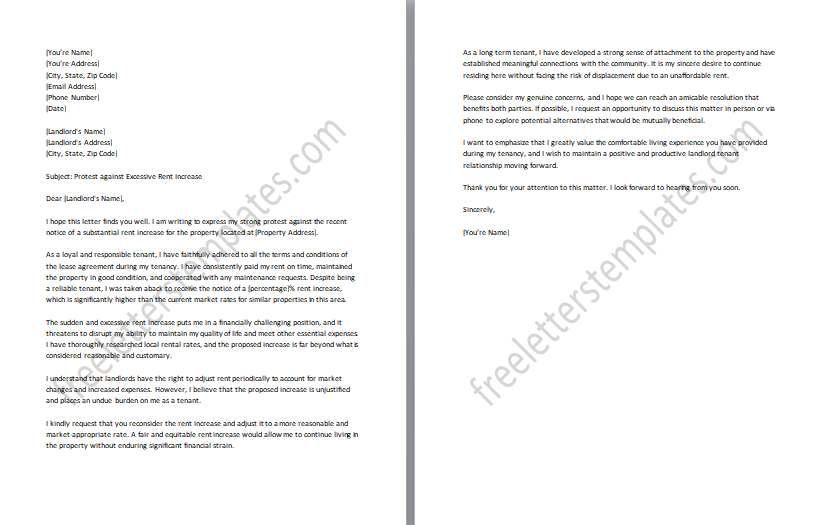
Legal Considerations for Lease Termination:
- State-Specific Laws: Lease termination laws can vary significantly from one state to another. It’s essential to understand the specific regulations governing your state, including the required notice periods and other legal requirements.
- Notice Period: Many states have laws that mandate a specific notice period for a lease. This notice period can range from 30 to 90 days, depending on the state and the circumstances surrounding the termination.
- Tenant Rights: Tenants have certain rights when it comes to leases. These rights may include the right to terminate early under certain circumstances, such as military deployment or domestic violence situations.
- Reasons for Termination: Lease laws often specify acceptable reasons for termination, such as breach of contract, uninhabitable conditions, or a property being sold.
- Security Deposit: State laws may outline the rules regarding the return of the security deposit to the tenant upon lease termination. It typically requires the landlord to provide an itemized list of deductions, if any, within a specific timeframe.
- Discrimination Laws: It is crucial to be aware of fair housing laws that prohibit discrimination based on race, color, national origin, religion, sex, disability, or familial status. These laws apply throughout the termination process.
- Tenant Remedies: In some cases, tenants may have remedies available to them if landlords do not comply with the termination laws. These remedies may include legal action or seeking damages.
- Legal Advice: Lease can be complex, especially when dealing with unique circumstances or specific state laws. It is advisable for both tenants and landlords to seek legal advice from a qualified attorney to ensure they are fully aware of their rights and obligations.
Clear Communication
- A well-crafted letter promotes clear communication between tenants and landlords.
- It outlines the tenant’s intent to terminate the lease in a straightforward and concise manner.
- The letter clearly states the specific date, leaving no room for confusion.
- It formally records the tenant’s decision to end the agreement.
- A clear minimize the risk of misunderstandings or misinterpretations regarding the process.
- It ensures that both parties are on the same page regarding the termination, avoiding unnecessary conflicts.
- By clearly communicating the tenant’s intention to vacate, the landlord can begin making necessary arrangements promptly.
- It allows both tenants and landlords to plan for the future and make any necessary adjustments.
Concluding Thoughts
In conclusion, our “Lease Termination Letters” website empowers tenants and landlords with valuable resources for an easy and confident process. We offer professionally crafted templates, informative guides on legal considerations, and common pitfalls to avoid. Whether you’re a tenant facing personal circumstances or a landlord responding to a termination request, we provide the necessary information to navigate the process smoothly. Remember to adhere to legal guidelines and seek legal advice when needed. Trust us as your reliable companion for a hassle-free and respectful lease journey. With our comprehensive tools and insights, we strive to make a stress-free experience for everyone, fostering positive landlord-tenant relationships.
← Previous Article
« Expertly Crafted 27 Contract Termination Letters: Ensuring Professional Closure